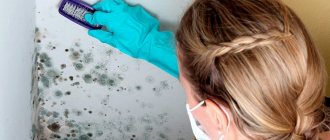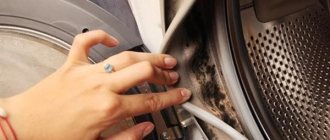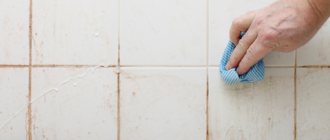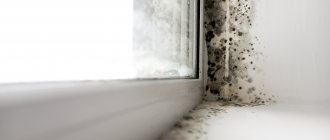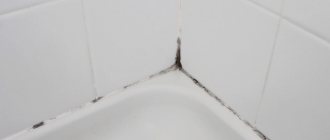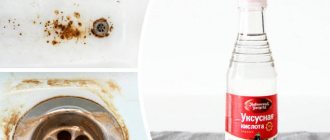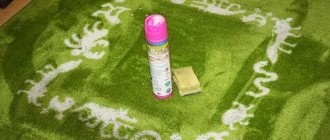Causes of mold and harm to the body
Mold develops due to increased concentration of moisture in an apartment or house. In residential premises, humidity should be no more than 80%. The following factors contribute to increasing its level:
- the presence of a large number of indoor flowers in the room;
- absence or ineffective operation of the ventilation system;
- wet laundry that is dried indoors;
- formation of condensation due to the difference in temperature outside and indoors;
- uneven heating of the home.
Most often, fungus appears in areas where moisture accumulates: on the ceiling, in the kitchen and bathroom, under windows, behind bedside tables, etc. If signs of damage appear, all necessary measures should be taken immediately.
The appearance of mold in a house or apartment poses a danger to humans. It is as follows:
- Pathogenic microorganisms spread throughout the home, as a result of which each member of the family is forced to inhale them. As a result, allergic pathologies may develop, accompanied by damage to the respiratory system. In addition, allergies often provoke the development of angioedema.
- Once on human skin, pathogens can cause the development of dermatological pathologies. Washing in a bathroom that has traces of mold can cause dermatitis or mycosis.
- Mold spores affect the cells of the human body, causing mutations. In most cases, dark mold can cause this. Getting into the tissues of internal organs, fungi cause the formation of neoplasms of a malignant nature.
- In some cases, a person may experience joint pain, a feeling of weakness and drowsiness. This is because mold negatively affects the functioning of the immune system.
To avoid problems, you need to choose an effective remedy that kills the fungus.
Precautionary measures
Despite the fact that most of the commercial products described above are absolutely safe for humans and pets, the treatment of premises with them should still be carried out in a protective suit, gloves and a respirator.
It is difficult to predict how the skin or the entire body will react to a particular chemical. In addition, we must not forget about the mold itself, which at the time of its removal can scatter throughout the room. The respirator in this case will prevent most small particles from entering the upper respiratory tract.
At the same time, we must not forget that preventing the appearance of fungus is much easier than fighting it. The main thing is to ensure normal ventilation and humidity in the bathroom. Then no mold will develop in it.
Otherwise, you will have to use modern fungicides and fight it chemically and mechanically, and if that fails, contact specialists.
Important! The content of all content presented on the site is for educational and informational purposes only, aimed at giving visitors to the resource a clearer understanding of various parasites and related diseases. It is strictly forbidden to use the information posted on the site for self-diagnosis and self-medication; always contact a specialist!
Rating of the TOP 7 best remedies for mold on walls
Place 1: Dali - universal antiseptic
An effective domestic antiseptic against mold and mildew. The cost of the product starts from 150 rubles. per bottle of 600 ml and depends on the point and region of sale. Dali solution can be applied to any surface, including plumbing fixtures, wallpaper, concrete and wood. With the help of this drug you can not only eliminate dampness, but also eliminate moss and fungus in the room.
The drug should be used taking into account the manufacturer's recommendations. Detailed instructions are indicated on the packaging of the substance.
Place 2: Fongifluid Alpa - active fungicide
This solution contains a fungicide. It is produced by the domestic company Alpa. The cost of a 2000 ml bottle is 540-560 rubles. The drug can be used not only indoors, but also outdoors (processing facade elements, roofing, etc.). The substance retains the shine and shade of the tile for a long time. Before applying it, loose and rough coatings must be leveled and sanded. Only in this case the composition will get into all the cracks and dimples.
In case of severe mold damage, treatment with an anti-mold and mildew agent on the walls should be performed 2-3 times. The drug should not be used in a cold room.
Place 3: Olympus-Stop mold
This mildew remover is recommended for basements, apartments, bathrooms, and greenhouses. The average cost of the composition is 100 rubles. per liter bottle. The product can be used to treat concrete, wood, brick and ceramics.
Place 4: Biotol – bioantiseptic spray
This antiseptic is available in the form of a spray. It does not contain chlorine or toxic compounds. Used for treating balconies and kitchens. In addition, it can be used to eliminate mold on monuments and tombstones. The cost of the product is about 290-310 rubles. for a 500 ml bottle.
It is convenient to use the drug, because the bottle with it is equipped with a spray bottle. Before application, the surface must be cleaned with a stiff brush. The antiseptic should be kept on the coating for 3-4 hours. After this, putty the coating.
Place 5: Mavix-Bio
The cost of this domestic antiseptic solution starts from 565 rubles. for a container of 1000 ml. Experts recommend using it simultaneously with a water repellent.
Wall surfaces must be prepared before treatment. The product is applied according to the instructions, after which it is left for 2-3 hours.
The mold is then scraped off with a scraper or wire brush. Additional treatment with a water repellent helps protect the wall or ceiling from dust and moisture.
Place 6: Domestos for fungus
Housewives often use Domestos for fungus. The substance must be used to treat problematic seams. The procedure must be performed every 2-3 days for 2 weeks. Remains of fungus are removed using a cleaning composition. After each treatment, the seams must be thoroughly wiped with a dry cloth.
If the drug does not help remove mold, then it is better to resort to the services of professionals.
Location 7: Whiteness from mold
For Mold Whitening to work as effectively as possible, the substance must be used taking into account a number of rules. They need to treat foci of fungus. Particular attention must be paid to gutters, seams, joints and baseboards. Fungus whitening is often used for general cleaning. It allows you to capture large areas.
After applying the anti-mold product, the surfaces must be completely dry. To speed up the process, you can use heating equipment. Remaining dirt is removed with a stiff brush.
If Belizna or Domestos do not help, then it is necessary to use more powerful fungicidal mixtures.
Folk remedies for mold
To combat mold fungus, you can use available home methods. The most effective among them:
- Copper sulfate. This substance has been used since USSR times. To prepare a disinfectant, 100 g of the product must be diluted in 10 liters of clean water. The prepared solution must be applied to the wall or ceiling.
- Borax. To combat mold, you need to dilute the substance with water in a ratio of 1 to 10. The composition is applied with a brush and left until completely dry.
- Soap solution. An effective antiseptic. To prepare it, you need to dilute the laundry soap with clean water. The solution is used only for preventive purposes.
- Hydrogen peroxide. A 3% peroxide mixture is suitable for removing mold and mildew. After applying the substance to the affected areas, you need to wait about 10 minutes. After this, the walls are cleaned with a stiff brush.
- Grapefruit seeds. To prepare an antiseptic, you need to dilute 20 drops of grapefruit seed oil with 500 ml of warm water. The finished composition is applied to the surface and left until dry.
- Vinegar. This substance must be used in its pure form. When using it, you need to wear rubber gloves and a mask.
- Tea tree extract. This remedy is effective only when there is an insignificant accumulation of fungus on surfaces. To work, you need to prepare a mixture of 1 part oil and 50 parts water in advance. The solution is applied to the coating using a sprayer. In this case, only problem areas need to be treated. There is no need to rinse off the substance. You just have to wait for it to dry completely.
- Soda solution. You can clean the walls with a solution of 1 tsp. soda powder and 500 ml of water. The finished mixture is applied to the surface and processed with brushes. If necessary, repeat the treatment.
In addition, ordinary potassium permanganate helps get rid of mold. However, it has a drawback - it colors the treated surfaces light pink.
Gentle methods
When black mold is detected, when the damage to surfaces is minimal, it must be eliminated immediately. There are many ways to remove mold in the bathroom, and they all require minimal effort and expense. Of course, you can try to resort to the help of professionals who can completely treat the bathroom with special products, but it is better to first try to eliminate the contamination on your own. Special anti-mold products that can effectively clean surfaces will help you with this. Nowadays, a lot of anti-black mold products have been developed, which differ in composition and method of removing the consequences.
You can clean mold using:
Bleach You can clean smooth surfaces - tiles, mirrors, bathtubs, sinks - with bleach. The fact is that almost any bleach contains sodium hypochlorite, which is characterized by increased activity against microflora
Using bleach, you can clean the tiles, seams and pores in the bathtub enamel from ingrained mold in a matter of minutes. It should be noted that this method requires special care, since the vapors of the active substances are aggressive and can cause diseases of the lungs, bronchi and eyes. You should quickly apply the active substance to contaminated surfaces, then leave the bathroom for half an hour
Then the surfaces are quickly rinsed and the room is ventilated; Ammonia You can remove mold in the bathroom using the well-known ammonia. This method is also dangerous because ammonia vapors can cause breathing problems and eye damage. Smooth surfaces should be treated with a multiple solution of ammonia in water, spraying it everywhere in an even layer. After an hour or two, surfaces and seams are washed with clean water, and the room is dried; Acetic acid As you know, mold and mildew are afraid of ordinary vinegar. Using vinegar essence, you can easily clean mold-affected areas if the damage to surfaces has just begun. It is important that vinegar is relatively harmless, although you also need to be careful when working with it. The processing algorithm is as follows: vinegar is poured into a spray bottle, the liquid is sprayed onto the tiles, seams, bathtub and sink, after which some time is given for the reaction to take place. After this, the surfaces are washed with water, and the bathroom is left to ventilate. The low cost of the method allows vinegar prophylaxis to be performed every few weeks or more often; Perhydrol Another household liquid that is found in most home medicine cabinets - hydrogen peroxide - can also help deal with black mold. The relative harmlessness and availability of the substance allows you to treat large surfaces in undiluted form. Suitable for processing any materials, it has a whitening effect, as a result of which, before starting spraying, hydrogen peroxide must be applied to a small test area. Perhydrol can be applied to joints and ceramic tiles.
Necessary tools and products for removing mold and mildew
In order for the processing to be as safe and effective as possible, you must first prepare all the necessary equipment. To combat mold you will need:
- spacious bucket;
- bottles equipped with sprayers;
- protective equipment (respirator, masks, goggles);
- brushes;
- rags;
- rollers and brushes;
- spatulas;
- basin with water;
- antiseptic compounds.
Measures to prevent mold and mildew
To prevent the development of mold and mildew in the apartment, you need to follow the recommendations of specialists. Among them:
- wall and ceiling surfaces must be systematically checked for the presence of fungal infections and moisture;
- there should be no defects in the coating in the form of cracks or chips; if they are found, they must be repaired immediately;
- the room must be regularly ventilated;
- Periodically you need to check the ventilation system for blockages and debris;
- when redecorating the walls, they need to be treated with antiseptic preparations;
- Leaks should be dealt with promptly;
- the soil in pots with indoor plants should be regularly checked for traces of mold;
- It is forbidden to put wet things in the wardrobe.
By adhering to these rules, you can prevent the development of fungus and mold in your apartment.
The main thing about the problem
Interestingly, mold appeared about 200 million years ago. The fungus successfully survived both the Ice Age and heat waves. And even in areas with active background radiation, where other flora and fauna die, scientists find large amounts of spreading mold. It’s unpleasant and even scary to have such a “neighbor” in your bathroom. How to wash and destroy blackness with your hands in an apartment?
Characteristics of species
Black, blue, red, white, fluffy... It's hard to say what kind of nasty thing this is. Removing damp from walls is hard work. The following table will show what the color and texture depend on, how to clean it, and what types of mold there are.
Table - Characteristics of mold types
| Color | Development conditions | What does it look like |
| Black and gray mold | — Rooms with high humidity levels | - Local or grouped black spots - in the early stages the fungus is colorless |
| White mold | - Food; - soil for indoor plants; - wet surfaces | — White coating with a fibrous texture; - fluffy surface |
| Blue-green or blue mold | — Wood and other natural finishing materials; - brick; - soil for indoor plants; - Food | — Blue or green plaque with uneven texture |
| Pink mold or red mold | - Plants; - rotting products | — Matte coating; - fluffy texture |
What is the danger
Fungus not only spoils the appearance of the finish, but also destroys the structure of the materials. But this is nothing compared to the harm spores can cause to human health. Why is mold in the bathroom dangerous? It can cause the following problems:
- skin rashes;
- eczema;
- hair loss;
- nail fungus;
- fatigue and lethargy;
- frequent attacks of headache;
- chronic runny nose;
- cough;
- conjunctivitis;
- bronchial asthma;
- intoxication of the body;
- rheumatic pains;
- indigestion;
- internal bleeding.



